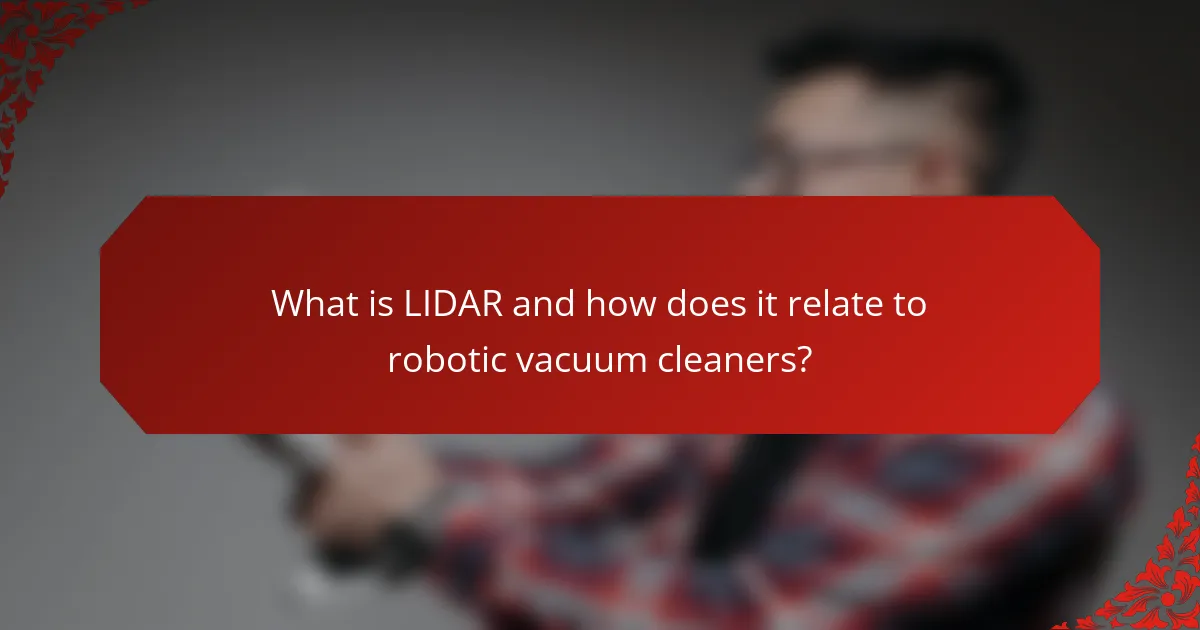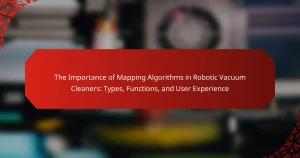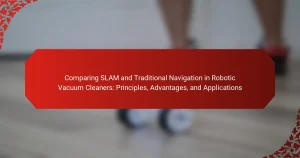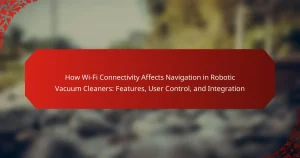LIDAR, or Light Detection and Ranging, is a remote sensing technology that utilizes laser light to measure distances and create detailed three-dimensional maps of environments. In the context of robotic vacuum cleaners, LIDAR plays a critical role in enabling efficient navigation and mapping of spaces. This technology allows robotic vacuums to plan optimal cleaning routes, avoid obstacles, and ensure comprehensive coverage of areas. The article explores the benefits, functionality, and limitations of LIDAR in robotic vacuum cleaners, highlighting how it enhances cleaning efficiency compared to traditional methods.

What is LIDAR and how does it relate to robotic vacuum cleaners?
LIDAR stands for Light Detection and Ranging. It is a remote sensing technology that uses laser light to measure distances. LIDAR systems emit laser pulses and analyze the reflected light to create precise, three-dimensional maps of the environment. In robotic vacuum cleaners, LIDAR enables navigation and mapping of spaces. This technology allows the vacuum to efficiently plan cleaning routes. It helps avoid obstacles and ensures thorough coverage of the area. Many modern robotic vacuums utilize LIDAR for enhanced performance. This results in improved cleaning efficiency compared to traditional methods.
How does LIDAR technology function in robotic vacuum cleaners?
LIDAR technology functions in robotic vacuum cleaners by using laser beams to map the environment. The vacuum emits laser pulses and measures the time it takes for the light to bounce back. This process creates a detailed 2D or 3D map of the surroundings. The robot can identify obstacles and navigate efficiently. LIDAR enables precise localization and path planning. It enhances the vacuum’s ability to clean systematically. Studies show that LIDAR-equipped robots can cover areas faster and more thoroughly than those without it.
What are the key components of LIDAR systems used in these devices?
The key components of LIDAR systems used in robotic vacuum cleaners include a laser source, a rotating mechanism, sensors, and a processing unit. The laser source emits light pulses to measure distances. The rotating mechanism allows the laser to sweep across the environment. Sensors detect the reflected light from objects. The processing unit analyzes the data to create a map of the surroundings. These components work together to enable navigation and obstacle avoidance. The accuracy of LIDAR systems is enhanced by the precision of the laser measurements.
How does LIDAR mapping differ from other navigation technologies?
LIDAR mapping differs from other navigation technologies by using laser light to measure distances. It provides high-resolution, three-dimensional maps of the environment. Other technologies, like ultrasonic sensors, rely on sound waves, which can be less accurate. LIDAR can capture detailed features in complex spaces. It operates effectively in various lighting conditions, unlike optical systems that depend on visible light. This precision allows robotic vacuum cleaners to navigate efficiently and avoid obstacles. Studies show LIDAR-equipped devices achieve better cleaning coverage compared to those using traditional navigation methods.
What are the main benefits of using LIDAR in robotic vacuum cleaners?
LIDAR in robotic vacuum cleaners offers precise mapping and navigation. This technology uses laser light to create a detailed 2D or 3D map of the environment. Accurate mapping enables the vacuum to identify obstacles and plan efficient cleaning routes. LIDAR-equipped models can clean larger areas in less time compared to traditional sensors. They also adapt to changes in the environment, such as moving furniture. Additionally, LIDAR improves boundary detection, preventing the vacuum from falling off stairs or entering restricted areas. Studies show that LIDAR enhances overall cleaning efficiency and reduces missed spots.
How does LIDAR improve cleaning efficiency and effectiveness?
LIDAR improves cleaning efficiency and effectiveness by providing precise spatial mapping of environments. It enables robotic vacuum cleaners to create accurate floor plans. This technology allows for optimal path planning during cleaning tasks. LIDAR-equipped devices can detect obstacles and navigate around them seamlessly. As a result, they minimize the time spent on repetitive cleaning. A study by the International Journal of Advanced Robotic Systems found that LIDAR enhances coverage by up to 30% compared to traditional sensors. This increased coverage leads to more thorough cleaning in less time. Overall, LIDAR significantly boosts the performance of robotic vacuum cleaners.
What advantages does LIDAR provide in terms of obstacle detection?
LIDAR provides high-precision obstacle detection using laser scanning technology. It generates detailed 3D maps of the environment. This allows robotic vacuum cleaners to identify obstacles accurately. LIDAR systems can detect objects at various distances. They work effectively in different lighting conditions. The technology offers real-time data processing for immediate responses. Research indicates that LIDAR can reduce collision rates significantly. Studies show that LIDAR-equipped devices navigate more efficiently than those using traditional sensors.
What limitations does LIDAR present in robotic vacuum cleaners?
LIDAR in robotic vacuum cleaners has several limitations. One major limitation is the high cost of LIDAR sensors, which can increase the overall price of the vacuum. Another limitation is that LIDAR performance can be affected by ambient light conditions. Bright sunlight can interfere with the sensor’s ability to accurately map the environment. Additionally, LIDAR may struggle with reflective surfaces, causing inaccuracies in navigation. The technology can also be less effective in cluttered spaces, where obstacles may obstruct the sensor’s view. Furthermore, LIDAR systems typically require more power, which can reduce battery life. These limitations can impact the efficiency and effectiveness of robotic vacuum cleaners.
How does the cost of LIDAR technology impact the price of robotic vacuum cleaners?
The cost of LIDAR technology directly increases the price of robotic vacuum cleaners. LIDAR systems are sophisticated sensors that provide accurate mapping and navigation. These sensors are expensive to manufacture and integrate into devices. As a result, robotic vacuum cleaners equipped with LIDAR tend to be priced higher than those using simpler navigation methods. For example, LIDAR-equipped models can range from $300 to over $1,000. In contrast, basic models without LIDAR are often priced under $300. This price disparity reflects the advanced capabilities and precision that LIDAR technology offers. Consequently, consumers pay more for the enhanced performance and features associated with LIDAR-enabled robotic vacuum cleaners.
What environmental factors can affect LIDAR performance?
Environmental factors that can affect LIDAR performance include weather conditions, surface reflectivity, and obstacles. Rain, fog, and snow can scatter LIDAR signals, reducing accuracy. Surface materials, such as dark or absorbent surfaces, can also diminish the reflection of LIDAR signals. Additionally, physical obstructions like furniture or walls can block or reflect the signals unpredictably. These factors can lead to inaccurate distance measurements and hinder the overall effectiveness of LIDAR in robotic vacuum cleaners.
How does LIDAR compare to other navigation technologies in robotic vacuum cleaners?
LIDAR offers superior navigation capabilities in robotic vacuum cleaners compared to other technologies. It uses laser beams to create precise maps of the environment. This results in accurate obstacle detection and efficient path planning. In contrast, infrared and ultrasonic sensors have limitations in range and precision. They may struggle in complex environments with varying surfaces. LIDAR can also operate effectively in low-light conditions, unlike some camera-based systems. Studies show that LIDAR-equipped vacuums clean more thoroughly and quickly than their non-LIDAR counterparts. This efficiency leads to better coverage and reduced cleaning time.
What future advancements can we expect for LIDAR in robotic vacuum cleaners?
Future advancements for LIDAR in robotic vacuum cleaners include improved accuracy and resolution. Enhanced sensors will allow for better mapping of complex environments. This will enable more efficient cleaning paths. Additionally, advancements may lead to real-time obstacle detection and avoidance. Integration with smart home systems is also expected to increase. These developments can enhance user experience and convenience. Research indicates that LIDAR technology is evolving rapidly, with increased affordability and miniaturization. This will likely lead to wider adoption in consumer-grade robotic vacuums.
What tips can enhance the performance of LIDAR-equipped robotic vacuum cleaners?
To enhance the performance of LIDAR-equipped robotic vacuum cleaners, ensure proper placement of the device. Position the vacuum in areas with minimal obstacles to improve navigation efficiency. Regularly clean the LIDAR sensors to maintain accuracy in mapping and obstacle detection. Update the vacuum’s firmware to benefit from the latest performance improvements and features. Schedule cleanings during low-traffic times to maximize effectiveness. Utilize virtual barriers to guide the vacuum in complex spaces. Ensure the floor is free of loose items to prevent disruptions during cleaning. These practices can significantly improve the operational efficiency of LIDAR-equipped robotic vacuum cleaners.
LIDAR, or Light Detection and Ranging, is a remote sensing technology that significantly enhances the functionality of robotic vacuum cleaners by enabling precise navigation and mapping. This article explores how LIDAR technology operates within these devices, detailing its key components and comparing its effectiveness to other navigation methods. It also highlights the benefits of using LIDAR, including improved cleaning efficiency and obstacle detection, while addressing limitations such as cost and environmental factors that can affect performance. Future advancements in LIDAR technology and practical tips for optimizing its use in robotic vacuums are also discussed, providing a comprehensive overview of its role in modern cleaning solutions.


